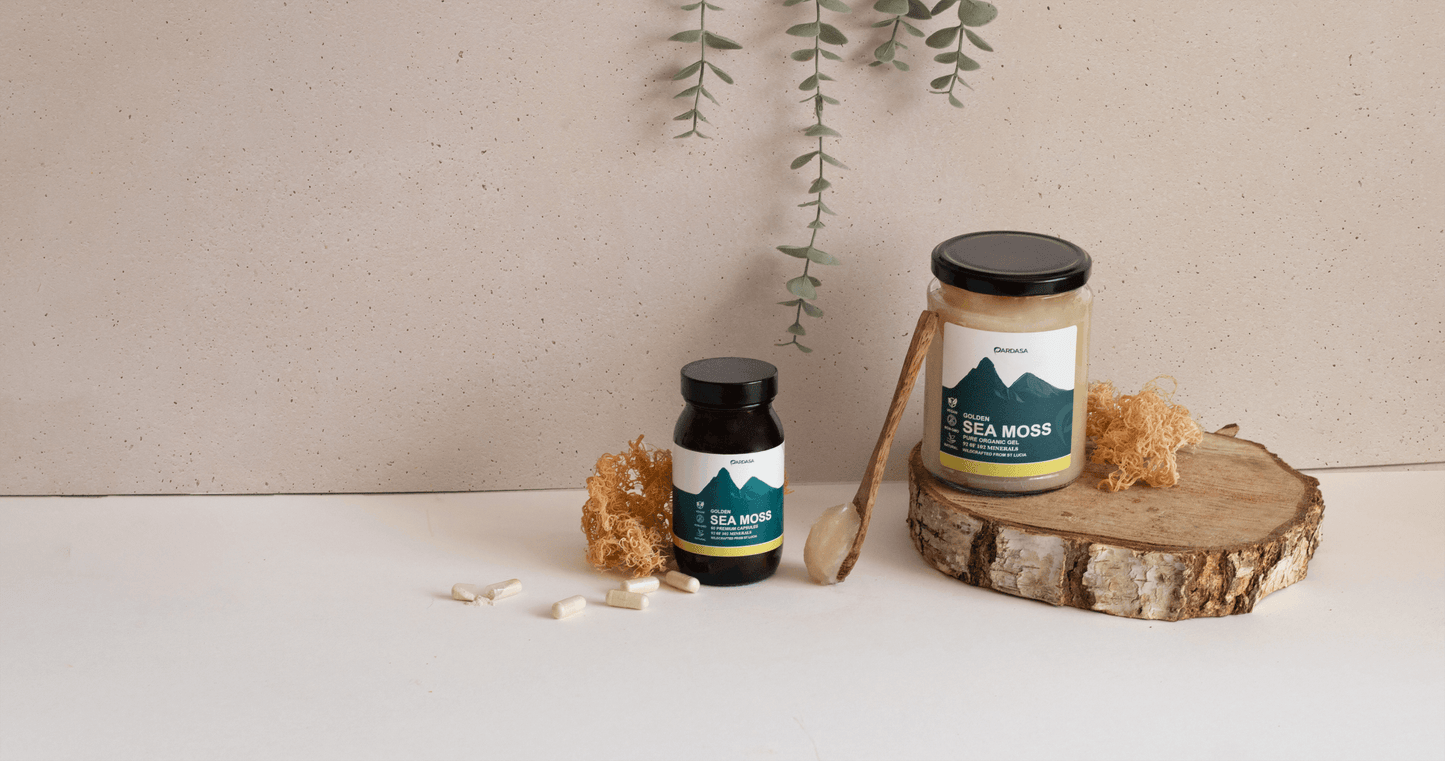
So you’ve heard about the amazing benefits of sea moss but now you’re probably wondering which is the best form to take, the sea moss gel or the sea moss capsules?
As with anything in the world of health and wellness, there is no one size fits all, so let’s delve into the benefits of both so you can work out which is going to be the best fit for you.
What are the benefits of taking sea moss as a gel?
- On a practical level, sea moss gel is a simple way to pimp up your smoothies and shakes with the boost of nutrients that sea moss provides, such as vitamin C, essential minerals, antioxidants, omega 3, essential amino acids (proteins) etc.
- You might have also noticed that the gel is kind of gloopy (technical term), this is specifically because it contains a type of soluble fibre called mucilage which swells up when it comes into contact with water.
- Mucilage comes with a host of benefits, it’s a prebiotic fibre (feeds your friendly gut bacteria) and is associated with higher levels of beneficial bacteria such as bifidobacteria and lactobacillus. These well fed microbes will, in turn, produce plenty of short chain fatty acids (SCFAs) which are the main fuel source for the cells of your colon (1). SCFAs also play a role in your metabolic health (supporting weight loss, healthy lipids and balanced blood sugar levels) (2).
- Mucilage is also associated with lower levels of not so friendly bacteria such as clostridium septicum and streptococcus pneumonia (the latter could potentially play a role in the link between sea moss and reduced upper respiratory tract infections) (1).
- The benefit of this prebiotic fibre goes beyond the balance of microbes, it can also help to alleviate both constipation and mild diarrhoea, so may be helpful for those with IBS.
- When added to shakes/smoothies, mucilage will also delay the absorption of any glucose (sugar) you might have added in the form of fruit/agave/maple syrup etc, preventing a blood sugar spike (this is good news for healthy insulin levels and fat loss).
- Sea moss also contains many phytochemicals such as flavonoids and triterpenoids (some more cracking names for you) which have been shown to have both antioxidant and antidiabetic properties when mixed with water. This means a reduction in allergies, inflammation and again reduced blood sugar spikes after meals (3).
So what are the benefits of sea moss capsules?
- The main benefit of taking sea moss in capsule form is the higher potency of minerals, this is particularly important if you are mineral deficient, which, let’s face it, is pretty common due to poor dietary intake, high stress levels, heavy menstrual cycles and poor digestive absorption.
- The capsules are also a more concentrated dose of the many other nutrients that sea moss provides such as amino acids, vitamins, essential fatty acids etc.
- If the convenience factor is important to you then the capsule might be the best option in terms of ease and limited preparation (they don’t need to be blended, but you do have the option to empty them into shakes/smoothies if you like).
- The shelf life of the capsules is also much longer than the gel (up to 12 months).
Conclusion
Both sea moss gel and capsules have their pros and cons. If you're interested in the benefits of mucilage and enjoy adding nutrients to your smoothies, the gel is an excellent option. However, if you prefer a more convenient, higher dose of nutrients, the capsules might be the better choice for you.
Caution on dosing: You might be thinking that because the capsules are more potent, the more you have, the more bang for your buck….. Well no actually, just as you shouldn’t go crazy taking mega doses of supplements, it’s also recommended you take the same caution with dietary sources, particularly ones that are high in iodine, so don’t exceed the recommended daily dose (1-2 capsules/day OR 1-2 tablespoons/day).
The content in this article is not intended to be a substitute for professional medical advice, diagnosis, or treatment. Always seek the advice of a qualified health provider with any questions you may have regarding your health.
REFERENCES:
- Cherry P, et al. ‘Prebiotics from seaweeds: An Ocean of Opportunity?’ Marine Drugs. 2019 Jun; 17(6), 327. https://www.ncbi.nlm.nih.gov/pmc/articles/PMC6627129/
- McNabney SM, et al. ‘Short Chain Fatty Acids in the Colon and Peripheral Tissues: A Focus on Butyrate, Colon Cancer, Obesity and Insulin Resistance. Nutrients. 2017; 9(12):1348. https://www.mdpi.com/2072-6643/9/12/1348/htm
- Prasasty V, et al. ‘Evaluation of Antioxidant and Antidiabetic Activities from Red Seaweed (Eucheuma cottonii). Systematic Reviews in Pharmacy. 2019; 10. 276-288 https://www.researchgate.net/publication/339882337_Evaluation_of_Antioxidant_and_Antidiabetic_Activities_from_Red_Seaweed_Eucheuma_cottoni

After reading this page I am undecided I am looking for the most affected one that is going to do the best work and what company make the best
Hi what is best source for sea moss ? Tablets or from the jar 🫙. Can I purchase at local supermarket? Coles or Woolworths?